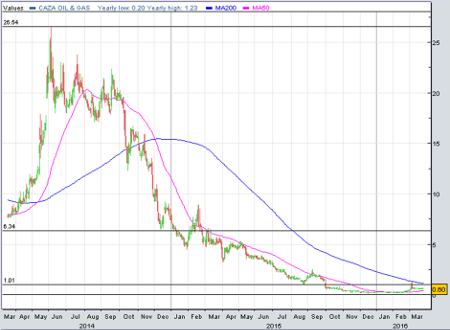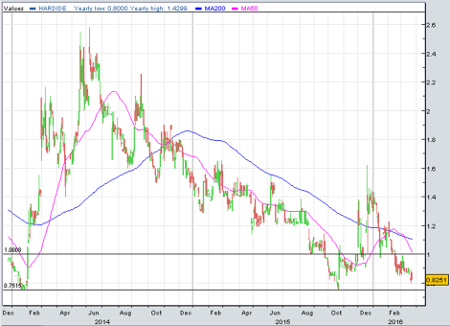Should you buy shares worth less than 1p?
24th March 2016 15:55
by Andrew Hore from interactive investor
Share on
Some people seem to believe that if they invest in penny or sub-penny shares there is limited downside because the share price has already fallen back. The demise of shows that, whatever the share price is, an investor can still lose 100% of their investment.
At the end of February, there were 126 companies on AIM with a share price of less than 1p. This does not include shares that are suspended, so there may be a few more on top of that - Motive was one of the shares suspended at the time and has since filed for administration.
It is very rare for a company to join AIM with a share price of less than 1p, even when it reverses into an existing shell. The vast majority of these companies have seen their share prices crash due to disappointing and failed businesses.
These companies have a total market value of £560 million, which is less than 1% of AIM’s market capitalisation, even though they are more than 12% of the companies on the junior market. The largest company is , which is valued at £41.5 m million, while is valued at £37.6 million. There are 29 companies in the list with a value of less than £1 million.
It is probably no surprise that 21 of the 126 companies are oil and gas companies and 52 are miners. If anything, this understates the number of resources companies. That's because , , , and , among others, are still in their old sectors in the AIM statistics, and are not included in the resources sectors despite either having acquired oil and gas or mining assets, or become investment companies focused on resources.
A growing sector
The number of sub-penny shares has increased significantly. At the end of 2010, there were 63 companies with a share price of less than 1p, which was around 5% of the companies on AIM at the time. Six of them were resources companies, so the main reason behind the subsequent increase appears to be the large number of ailing resources companies. Many of the companies at the end of 2010 are the same as the ones in the February 2016 list, although some of them have gone bust or just left AIM.
and have both undergone share consolidations in the past five years and they did it at a time of strength. This means that they are no longer penny shares - both of them have higher share prices even when adjusted for the consolidation.

Other companies could consolidate their shares and get a more significant share price, but that could lead to a sharp fall in the consolidated price if the business is performing poorly. Motive TV provides an example of this, because its share price was lower when it left AIM than back in 2010, even though it has undertaken two consolidations since then.
Take health services provider as an example. The original internet business floated 16 years ago and the share price slumped. It was trading at 0.55p at the end of 2010 and is now 70p a share*. However, that is after a 100-for-one consolidation, so the equivalent is 0.7p a share. The Totally share price has quadrupled since July, yet it is still half the level it was three years ago.
Part of the reason behind this is that companies that have plunged so far have little cash in their balance sheets, and they tend to need to regularly raise cash to keep going. This dilutes existing shareholders and can keep the share price down. Totally has successfully built up its business in the past year and it is in a strong position to prosper, but it is rare among former sub-penny shares.
The 99% club
Fifteen out of the 20 worst performers on AIM over five years have a share price of less than 1p, while only two of the other five have a share price above 5p, and one of those was only due to a 100-for-one share consolidation. That is not that surprising, because they have all fallen by 99% or more.
In contrast, none of the top 20 performers over five years started with a share price of less than 1p. A few did have share prices of less than 10p, but this is relatively rare.
There is a theory that a company with a very low share price can increase it more easily than if it had a high share price. The figures show that this is a fallacy because, given the large number of companies with sub-1p share prices, it would be thought that at least one would be in the top 20 risers, whereas there is not even one in the top 30.
Even more importantly, the bid/offer spreads for these shares can be enormous. For example, has a bid/offer spread of 0.03p/0.07p - a mid-price of 0.05p. This means that, assuming the spread does not narrow, the mid-price has to rise to 0.09p in order to sell the shares and breakeven. That means that the share price has to increase by 80% in order to breakeven and that does not include any dealing costs.
has a spread of 0.08p/0.15p. If shares were bought at 0.15p then the mid-price would have to rise from 0.115p to 0.185p - an increase of three-fifths - in order to breakeven.
In contrast, transport optimisation software and services provider , whose shares are more than 10 times the level they were five years ago, has a spread of 495p/510p, so the mid-price can move from 502.5p to 517.5p to breakeven -an increase of less than 3%.
This indicates that it is easier to make gains with lower spreads, which are rarely enjoyed by low-priced shares. There is also greater likelihood of a growing company increasing its share price than there is for a stagnant sub-penny share.
Companies with share prices of less than 1p are unlikely to have a strong track record, but there is recovery potential in some cases. However, these recoveries are likely to take some time and may not be smooth. These two companies have relatively narrow, if still significant, spreads for such low-priced shares.
Hardide
0.85p
Advanced coatings supplier has been making progress towards profitability, but the weak oil price has hit the business. The oil and gas sector is a major customer for its coatings and demand has slumped. The recent trading statement led to forecast downgrades. The underlying loss is expected to treble to £1.5 million this year.
Hardide is building up its non-oil and gas business, but it is taking a long time. Aerospace and precision engineering revenues have doubled from a low base.
The firm is expected to still have net cash by the end of September 2017 on the current forecasts. Any upturn in oil drilling activity will boost oil and gas demand and lead to a reduction of losses. New customers will also help.

Hardide has been quoted for well over a decade and progress has been slow, but it appears to be reaching a point where it can start to make money. Oil and gas sector weakness has delayed this, but it should still happen. The more business that is pushed through the UK and US facilities, the faster profitability will be achieved.
There is no certainty that Hardide will succeed, but the signs are that it could become a profitable business. That would lead to a re-rating of the shares, although investors will need to be patient.
Cyan Holdings
0.16p
is another company with more than ten years on AIM, and it is a prime example of an AIM company with technology that still hasn't generated significant revenues so that it can move into profit.
The fact that investors have been willing to invest £450,000 in new shares at 0.18p each - a premium to the market price - suggests that they believe there are good prospects for the business, although the Enterprise Investment Scheme relief will have helped.
The smart meter and lighting controls wireless technology developer has begun to win orders after years of delays by potential customers. Significant smart metering orders have been won in India and more recently an initial order from Iran, which has the potential to become much larger.
Smart meter roll-outs are planned in many Asian countries, with China a large potential market. There are likely to be hundreds of millions of smart meters installed in Asia over the next few years.
The trouble is that more cash is likely to be needed for working capital, especially if additional large orders are won. However, once revenues are built up enough to more than cover costs profitability should start to improve sharply as additional revenues come in.
*Share prices correct at time of writing.
This article is for information and discussion purposes only and does not form a recommendation to invest or otherwise. The value of an investment may fall. The investments referred to in this article may not be suitable for all investors, and if in doubt, an investor should seek advice from a qualified investment adviser.
These articles are provided for information purposes only. Occasionally, an opinion about whether to buy or sell a specific investment may be provided by third parties. The content is not intended to be a personal recommendation to buy or sell any financial instrument or product, or to adopt any investment strategy as it is not provided based on an assessment of your investing knowledge and experience, your financial situation or your investment objectives. The value of your investments, and the income derived from them, may go down as well as up. You may not get back all the money that you invest. The investments referred to in this article may not be suitable for all investors, and if in doubt, an investor should seek advice from a qualified investment adviser.
Full performance can be found on the company or index summary page on the interactive investor website. Simply click on the company's or index name highlighted in the article.
Disclosure
We use a combination of fundamental and technical analysis in forming our view as to the valuation and prospects of an investment. Where relevant we have set out those particular matters we think are important in the above article, but further detail can be found here.
Please note that our article on this investment should not be considered to be a regular publication.
Details of all recommendations issued by ii during the previous 12-month period can be found here.
ii adheres to a strict code of conduct. Contributors may hold shares or have other interests in companies included in these portfolios, which could create a conflict of interests. Contributors intending to write about any financial instruments in which they have an interest are required to disclose such interest to ii and in the article itself. ii will at all times consider whether such interest impairs the objectivity of the recommendation.
In addition, individuals involved in the production of investment articles are subject to a personal account dealing restriction, which prevents them from placing a transaction in the specified instrument(s) for a period before and for five working days after such publication. This is to avoid personal interests conflicting with the interests of the recipients of those investment articles.